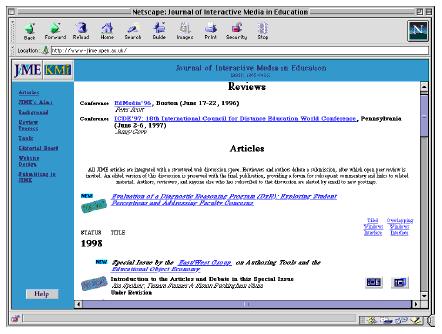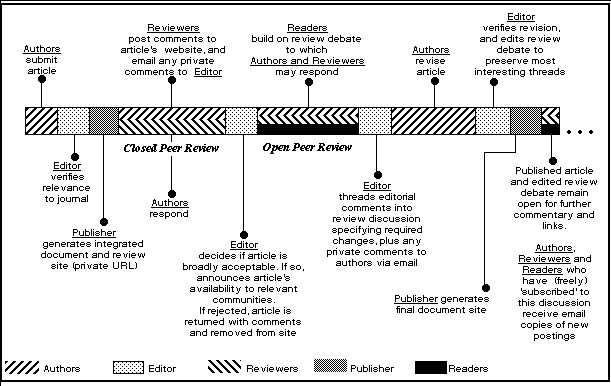Hypermedia Online Publishing: the Transformation of the Scholarly Journal
6.3.3 Journal of Interactive Media in Education
Overview
The Journal of Interactive Media in Education (JIME) was launched in September 1996 and is published by the Knowledge Media Institute of the Open University in the U.K. It is available online at <http://www-jime.open.ac.uk> . A representative opening screen is shown in figure 6-3.
|
|
- To foster a multi-disciplinary and intellectually rigorous debate on the theoretical and practical aspects of interactive media in education.
- To clarify the cognitive, social and cultural issues raised by the use of interactive media in education.
- To radically improve teaching and learning through better interactive media.
- To publish leading international research on the theories, practices and experiences in the field.
- To link scholars and commercial practitioners
- Through its innovative use of interactive Net-based media, to be an action research project which explores the changing face of journals, and more broadly, scholarly practice in the age of digital publishing and communication. [Anonymous, 1998a]
Access
Access to the journal is free (at this stage) and there is no indication on the Website of any plans to start charging. JIME is currently funded by the Open University, through the Knowledge Media Institute's (KMI) research budget, and other internal budgets as an action research project. KMI is in turn sponsored by a range of commercial organisations. JIME have had discussions with many publishers but find that the publishers are all locked into the idea that they're going to charge for access. JIME do not want this because of the effects on their open participatory model [Buckingham-Shum, 1998].
Navigation
JIME provides a heavily frames-based interface (although it can be used by a non-frames capable browser). The interface is now available in two versions: one with a floating comments window and one without. The version without is shown in figure 6-4. This version is optimised for larger screens (832 by 624 pixels or greater), and the screen capture shown is only at 800 by 600 pixels. The panel on the left shows a table of contents for the article. The panel in the middle shows the currently selected section within the article. The panel on the right shows the comments for the current article by section (the thumbs up indicates an approving response). Comments can be categorised as Agree, Disagree or None.
|
|
Presentation
The presentation of the articles is either in HTML or PDF. The printer icon at the foot of figure 6-4 links to a PDF version of the article displayed. Naturally, the PDF version only contains the formatted text of the article, losing the commentary, live navigation via hyperlinks and embedded simulations. Because of the hypermedia richness of JIME the paper version is significantly inferior.
Additional features
One of the things that distinguishes JIME is its integration of the review and publishing process. JIME has a publishing model that provides for both closed and open peer review as well as initial and ongoing peer commentary.
All JIME articles are integrated with a structured web discussion space. Reviewers and authors debate a submission, after which open peer review is invited. An edited version of this discussion is preserved with the final publication, providing a forum for subsequent commentary and links to related material. Authors, reviewers, and anyone else who has subscribed to that discussion are alerted by email to new postings. [Anonymous, 1998b]
The review process is depicted in figure 6-5.
|
|
Another of JIME's distinguishing features is its use of Shockwave and Java to support demonstrations or interactive examples embedded within articles. This allows readers to interact with the systems being described and enables the journal to model its own field of application.
Last modified: Monday, 11-Dec-2017 14:41:03 AEDT
© Andrew Treloar, 2001. * http://andrew.treloar.net/ * andrew.treloar@gmail.com


